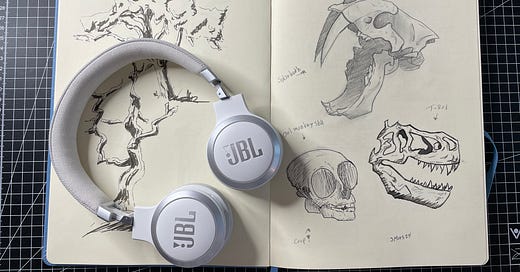A few years back, I fell into a peculiar hobby, collecting headphones. I didn’t buy them for reviews or recommendations; I just bought them because I wanted to. And to waste money for no reason! Cool, ha?
It was a strange period in my life. But I did learn a thing or two about noise-canceling headphones, the good and the bad.
So, I thought maybe it’s time to write about it. Good noise canceling headphones can really help us folks with ADHD and ASD in the long run. They certainly have for me.
Let's dive into what I use. My main ANC headphones are the Sony XM2. Yes, they are very old but still gold!
I also have the Audio Technica SR50BT, but those are noise reduction, not cancellation. And my latest pair is the JBL Live 670NC with adaptive cancellation.
Audio Technica and Sony are over-ear headphones, while JBL is on-ear. Let's break down the difference.
🟩 On-ear: These have small ear cups that sit directly on your ears. Over time, they can make your ears warm. But they generally work best with glasses.
🟩 Over-ear: These have much bigger cups that fit around your ears. They also have more padding, providing passive noise cancellation.
There are also in-ear buds, but I don’t use them and don’t like them. You shouldn’t either because they can be harmful to your ears.
Now, let’s move on to the different types of noise cancellation: Active, Adaptive, and Noise Reduction.
🟦 Noise Reduction: This is what my Audio Technica has, and it pretty much just reduces the noise. You can still hear some background noise. It doesn’t completely remove it. It’s good if you still want to be aware of your surroundings, but bad if you want to block out the world.
🟦 Active Noise Canceling (ANC): ANC headphones use microphones to pick up external sounds and then produce sound waves that are the exact opposite (anti phase) to cancel out the noise. This system is mostly fixed but can be manually adjusted in apps. It works best for low-frequency sounds like the hum of an airplane engine.
🟦 Adaptive Noise Canceling: This is a more advanced form of noise cancellation that also uses microphones to detect ambient sounds. However, it dynamically adjusts the level of noise cancellation based on the current environment and sound conditions. It automatically changes its setting in real-time and is better at handling varying and unpredictable noise environments.
Both active and adaptive are quite similar, but active is more popular because it handles consistent noise environments well.
My Sony headphones have active noise canceling, while my JBL has adaptive. And I can hear the difference. The biggest difference is that JBL is on-ear, making the adaptive more lacking compared to if I had their bigger brother.
My Sony blocks out way more sounds than them. Let me give you an example: If I use my Sony and someone is cutting vegetables, I wouldn’t hear it. With my JBL, I would still hear the cutting. Bom, bom, bom.
But if those JBL were over-ear, that would probably be a different story. My Audio Technica would hear it all.
The thing is, both active and adaptive work well for blocking out neighbors, street noise, and so on, even if they are on-ear. But if they were over-ear, both would be great to have anywhere!
In short, active noise canceling is best for environments with constant background noise, while adaptive is ideal for environments with fluctuating noise levels, such as moving between different types of transport or walking through a city.
Does this make sense? I would recommend either active or adaptive over-ear headphones! They are more comfortable to wear for longer periods of time.
A few examples are the Sony XM5, Bose QuietComfort, Sennheiser ACCENTUM Plus, and JBL Live 770NC, to name a few.
Support me at:






